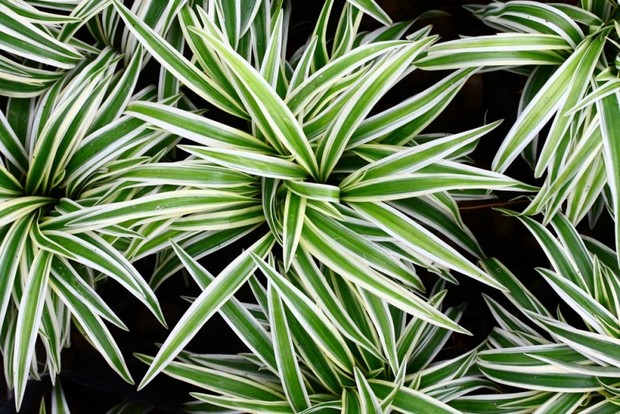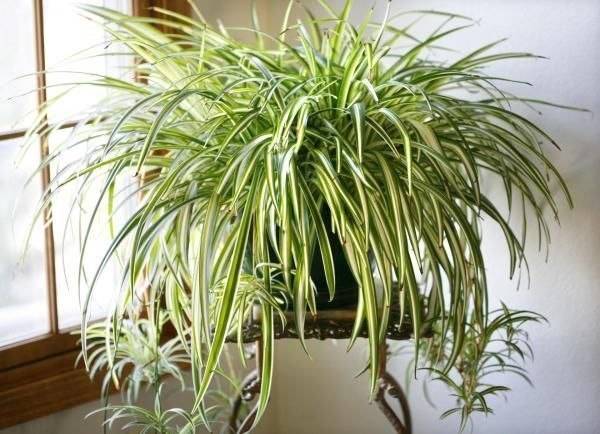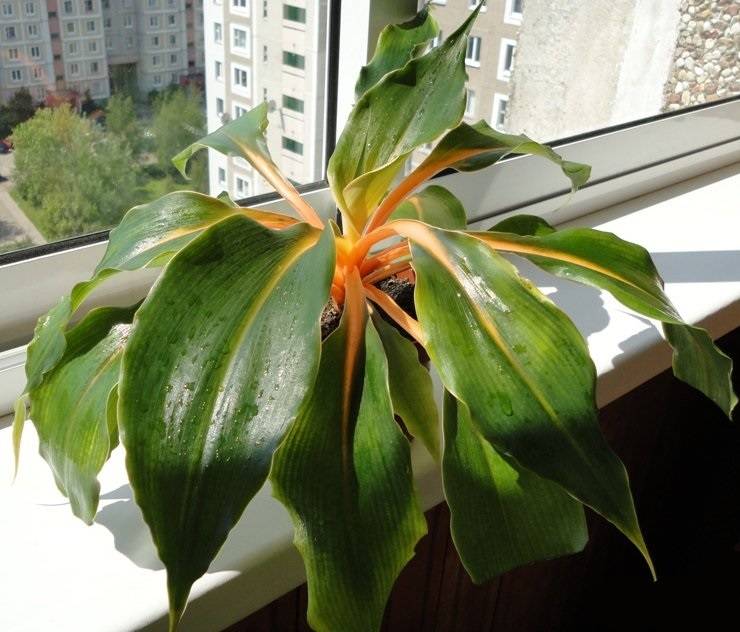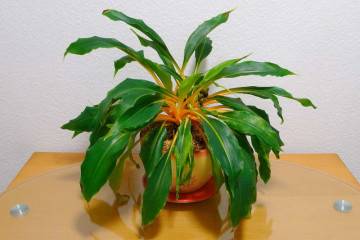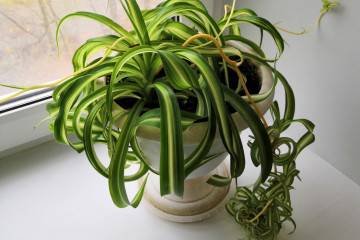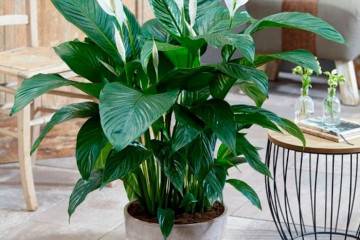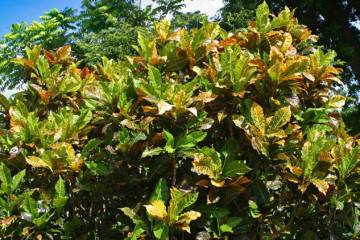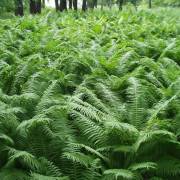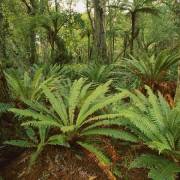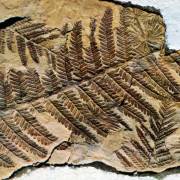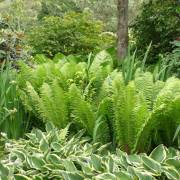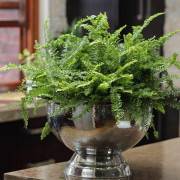Chlorophytum flower - species and varieties of plants
Content:
Few people know that chlorophytum came from a tropical climate, because the plant is known to many from childhood. Each variety is unique in its own way: spiral and striped leaves, orange petioles, hanging rosettes. The plant looks great in the interior and does not require special care: what else can any grower dream of?
Brief description of the plant
Chlorophytum naturally grows in the shade, but its homeland is Africa, so neither the sun nor the heat is afraid of it. In Europe, the plant began to grow in the 19th century.
Chlorophytum is a perennial plant with long hanging leaves and tendrils, from which new rosettes are formed right in the air. The leaves can be white-green, creamy green, or pure green, depending on the species.
This is one of the most unpretentious plants, which is why it is so popular in offices where very little attention is paid to it. According to some sources, it belongs to the asparagus family, according to others - to the Agavov family.
The shrub feels great in any light and actively develops in any soil. Chlorophytum is not a perennial garden plant, but an exclusively indoor plant.
The roots of Chlorophytum Green are capable of accumulating moisture, which is why rare watering does not affect the shoots in any way. If the flower is provided with ideal growing conditions, then it will release long leaves and multiple hanging babies.
The length of each leaf can reach 80 cm, diameter up to 50 cm. The life span of a plant exceeds 10 years, after which it can be renewed.
To enhance the beneficial effects of the plant, pieces of coal can be placed in the soil or on the pan of the pot, which will also draw in toxins. Together, they neutralize cigarette smoke, exhaust gases, bacteria.
Chlorophytum: types for home cultivation:
- Crested;
- Curly (Bonnie);
- Cape;
- Winged (Orange);
- Variegated;
- Laxum.
The plant is placed in children's rooms, schools, hospitals. Moreover, it is resistant to flower parasites and diseases.
Chlorophytum crested
Chlorophytum crested (Chlorophytum comosum) has a short stem and light green shoots. The shape of the leaf is narrow-lanceolate, the arrangement is arcuate. Each leaf is long and curved, striped in color.
On each specimen, flowers are formed at the ends of the shoots, which are later transformed into shoots. The length of the peduncles is up to 1 meter. They have moldings and roots, so they are used for reproduction.
Mature plants produce so many shoots that they form a kind of curtain. It is the leaves that give decorativeness to the view, and the flowers, which are not always noticeable against their background.
How the chlorophytum plant blooms
At home, flowering rarely occurs due to a lack of lighting or temperature. It can only be achieved in a greenhouse.
In the people and in stores, you can often hear the name chlorophytum komosum, we are talking about the bundle crested species, and from Latin the name is translated as "green plant".
In the process of cultivation, which has been going on for more than 200 years, on the windowsills of flower growers, crested chlorophytum has adapted to the home climate and has become resistant to various diseases.
Popular varieties
The most common varieties are presented below:
- Vittatum - has a green leaf with a longitudinal white stripe in the middle.
- Variegatum - on the contrary, the leaf is green in the middle, and the edges are silvery.
- Maculatum - yellow stripes run along the entire leaf.
- Curty Locks - leaves are long, wide, twisted into a spiral.
- Mandaianum is distinguished by one longitudinal yellow stripe.
- Ocean - the leaves have a light edging, the shape of the shoots is spiral.
Separately, it is worth highlighting some unique varieties. The first is Chlorophytum cv Charlotte. A distinctive feature is the absence of a mustache, so reproduction is carried out exclusively by dividing the bush and seeds.
What chlorophytum looks like Lemon is a low variety, maximum height up to 30 cm. Shade-tolerant, moisture-loving, prefers light drained soils. The variety was named Chlorophytum Lemon due to the color of the leaves, which have a yellow tint.
Many questions are raised by the Blue Pearl or Pearl Chlorophytum variety. Chinese online stores are actively offering to buy hanging pearl chlorophytum for growing from seeds. Sellers display photographs of a plant with blue beads strewn with long, dangling shoots. It is difficult to pass by such a proposal, but experienced flower growers know that this is nothing more than a deception.
A relatively new variety is Ocean, which appeared in 2012. The plant does not form children, the leaves are light green, up to 60 cm in length, as they grow, they twist into a spiral.
The winged variety (Orange, Marmalade, Orchidokhvezdny) has green leaves, shoot cuttings are bright orange, the edges of the leaves also have a thin orange outline. Leaves from a dense rosette grow up to 10 cm in length. The peduncle is small enough, and the flowers are spirally in relation to each other.
Each dangling rosette can be planted in a separate pot, thus obtaining a separate plant specimen. Rosettes with 4-5 leaves and small aerial roots are used. The rosettes, without tearing off the shoot, are buried in the soil and watered. After 2-3 weeks, the baby will take root and can be cut off.
Young specimens are transplanted into bowls or small pots. A mixture is prepared from leaf, turf and humus soil in the same proportion, sand is added.
Chlorophytum curly
Chlorophytum Curly or Bonnie (Chlorophytum comosum variegatum Bonnie) has leaves not hanging down, but wrapped around a pot. A wide white stripe runs along the green leaf; babies are formed at the ends of the shoots.
The leaf shape is linear-lanceolate, the root system is tuberous, thick, due to which the plant is able to accumulate a large volume of water, which is used in dry times.
When chlorophytum begins to bloom, the plant releases a long whisker, on the edge of which small white flowers appear. The flowering period is 6 months, which starts in March and ends in August. At the end of the period, fruits are tied and rosette babies with aerial roots appear.
When the plant grows, the crown completely covers the stem and soil. In order for the shrub to have a decorative appearance, an annual formative pruning and pinching is carried out. Leaves are cut at the root only in case of weakness or disease of the plant.
Curly chlorophytum care
Chlorophytum Bonnie almost does not require home care. It tolerates prolonged drought well, it will be able to stand even if it is not watered for a whole month. It is from the roots that it will take moisture all this time. Visually, the plant will look dull and lethargic, the curls will quickly straighten out. But the former will resume with the first watering.
If the leaves of the plant have dried up, they are simply cut off, this will not affect the health of the plant. In winter, watering is reduced to 1 time per week.
Chlorophytum loves spraying and shower, periodically the leaves need to be wiped from dust and dirt, especially in the hollow.
Poor conditions of detention can lead to infection of striped chlorophytum with parasites:
- mealybug;
- aphids;
- shield;
- spider mites.
In case of illness, mechanical leaf peeling and insecticides are used.
A well-known plant variety is Curty Locks. It has leaves with a similar color, which are twisted into a spiral.
Each type of chlorophytum that produces a mustache with a rosette needs a transplant once every 2-3 years. Such specimens grow very quickly and completely fill the entire volume of the pot with roots. With the wrong pot, the plant stops growing and giving flower stalks.
Optimal soil composition:
- leafy land;
- sod land;
- humus earth;
- sand.
Mature shrubs respond well to adding bone meal to the soil. If the shrub is too large, then it can be divided into several small bushes. Dividing the bush not only reduces its size, but also rejuvenates and prolongs the life of the bush.
The procedure is carried out as follows. In advance, the flower is watered abundantly so that the entire soil is wet and soft. After a few hours, the plant can be removed from the pot without risk of damaging the roots.
After the shrub is removed, the roots unravel. Chlorophytum is divided into several parts and is planted in pots with light nutritious soil. This is where the manipulations end, so the method is rightfully considered the simplest and fastest.
Chlorophytum Cape
Cape chlorophytum (Chlorophytum capense) is distinguished by narrow-lanceolate leaves up to 60 cm long, which are as thin at the base as at the ends. The middle of the leaf is wide, reaching 3 centimeters. The color of the leaves is light green, the edge is keel-shaped, not prickly, the leaves grow from the rosette, the roots are tuberous.
If you look closely, you can find a groove on the upper side of the sheet, and a keel on the lower side. This species has no processes, peduncles are long. Inflorescences are formed on the leaf axils, which are located on the peduncle.
The species is more hardy, it can develop at low subzero temperatures. The flower has no varieties.
Chlorophytum Laxum is a separate species, although it is often referred to as the Cape. It has long leaves that grow from a rosette, although the edge of the leaf has a white border. The plant does not form children, therefore reproduction is carried out only with the help of seeds. The similarity of seeds is only 25-40%, therefore, when growing a plant in this way, you will have to be patient. Care requirements are the same with other species.
Winged chlorophytum
Winged chlorophytum (Chlorophytum amaniense) is distinguished by wide lanceolate leaves of a dark green color with a narrow base.
The winged species has the following varieties:
- Green Orange;
- Fire Flash.
Both varieties of indoor chlorophytum have wide, dark green leaves and orange petioles.So that the flower does not lose color saturation, it is better to remove the peduncles. It is recommended to leave them only if further reproduction is necessary.
You can buy seeds for propagation, or you can collect them yourself from the fruits that develop from February to March. Before planting, the seeds are soaked in water for 24 itself, after which they are placed in a light moist soil, a mixture of leafy earth, peat and sand is ideal. I press the seeds a little into the soil, but do not bury them.
A dish with seeds is covered with glass or foil and placed in a room where the air temperature is more than 22 ° C. The first shoots will appear in about 1.5 months. The soil must be constantly moist, for this it is regularly sprayed.
Gradually, the glass is removed for a few minutes to adapt the sprouts to fresh air. Young chlorophytums can be transplanted into separate pots when 2-3 true leaves appear.
Each type and variety of chlorophytum has its own characteristics, but outwardly most of them are similar. Having received such a plant, you can not worry about caring for it, but just enjoy the unique, bright appearance of variegat chlorophytums and other varieties.
Video
